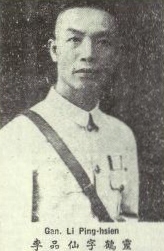| |||||
| Decades: | |||||
|---|---|---|---|---|---|
| See also: | Other events of 1945 History of China • Timeline • Years | ||||
Events from the year 1945 in the Republic of China. This year is numbered Minguo 34 according to the official Republic of China calendar.
| |||||
| Decades: | |||||
|---|---|---|---|---|---|
| See also: | Other events of 1945 History of China • Timeline • Years | ||||
Events from the year 1945 in the Republic of China. This year is numbered Minguo 34 according to the official Republic of China calendar.

Chiang Kai-shek was a Chinese nationalist politician, statesman, revolutionary and military commander who was the leader of the Nationalist Kuomintang (KMT) party and commander-in-chief and Generalissimo of the National Revolutionary Army (NRA) from 1926, and leader of the Republic of China (ROC) in mainland China from 1928. After Chiang was defeated in the Chinese Civil War by the Chinese Communist Party (CCP) in 1949, he continued to lead the Republic of China on the island of Taiwan until his death in 1975. He was considered the legitimate head of China by the United Nations until 1971.

The Chinese Civil War was fought between the Kuomintang-led government of the Republic of China and the forces of the Chinese Communist Party (CCP), with armed conflict continuing intermittently from 1 August 1927 until Communist victory resulted in their total control over mainland China on 7 December 1949.

Wang Zhaoming, widely known by his pen name Wang Jingwei, was a Chinese politician who was president of the Reorganized National Government of the Republic of China, a puppet state of the Empire of Japan. He was initially a member of the left wing of the Kuomintang (KMT), leading a government in Wuhan in opposition to the right-wing Nationalist government in Nanjing, but later became increasingly anti-communist after his efforts to collaborate with the Chinese Communist Party ended in political failure.

Li Zongren, courtesy name Telin, was a prominent Chinese warlord based in Guangxi and Kuomintang (KMT) military commander during the Northern Expedition, Second Sino-Japanese War and Chinese Civil War. He served as vice-president and acting president of the Republic of China under the 1947 Constitution.

The proposed Japanese invasion of Sichuan was the Imperial Japanese Army's failed plan to destroy the Republic of China during the Second Sino-Japanese War. It was to be a stepping stone for the Empire of Japan's final control of the Chinese mainland.

Zhang Fakui was a Chinese Nationalist general who fought against northern warlords, the Imperial Japanese Army and Chinese Communist forces in his military career. He served as commander-in-chief of the 8th Army Group and commander-in-chief of NRA ground force before retiring in Hong Kong in 1949.

The Second United Front was the alliance between the ruling Kuomintang (KMT) and the Chinese Communist Party (CCP) to resist the Imperial Japanese invasion of China during the Second Sino-Japanese War, which suspended the Chinese Civil War from 1937 to 1945.

The term Free China, in the context of the Second Sino-Japanese War, refers to those areas of China not under the control of the Imperial Japanese Army or any of its puppet governments, such as Manchukuo, the Mengjiang government in Suiyuan and Chahar, or the Provisional Government of the Republic of China in Beiping. The term came into more frequent use after the Battle of Nanking, when Chiang Kai-shek evacuated the government of the Republic of China to Chungking. It was also sometimes referred to as the Chungking Government or simply "Chungking," such as in the surrender speech of Hirohito to the Japanese military.

Li Pinxian was a Republic of China Army general from Cangwu County, Guangxi. His career spanned the Xinhai Revolution, Warlord Era, the Second-Sino Japanese War, and the Chinese Civil War. After the loss of the mainland to the Chinese Communist Party in 1949, he left for Taiwan.
The battle of Shaobo (邵伯战斗) took place in the Shaobo (邵伯) region in central Jiangsu, and it was a clash between the communists and the nationalists after World War II, and it is a prelude to Gaoyou Campaign. The battle resulted in communist victory was one of the Chinese Civil War in the immediate post World War II era.
Events in the year 1949 in China.
Events in the year 2003 in China.
Events in the year 1946 in the Republic of China. This year is numbered Minguo 35 according to the official Republic of China calendar.
Events in the year 1941 in China.
This is a list of events in the year 1947 in the Republic of China. This year is numbered Minguo 36 according to the official Republic of China calendar.
Events from the year 1930 in China.
Events from the year 1929 in China.
Events in the year 1955 in China. The country had an estimated population of 605 million people.
The following lists events in the year 1997 in China.
The following is a topical outline of English Wikipedia articles about the history of the Chinese Civil War (1912–1949)